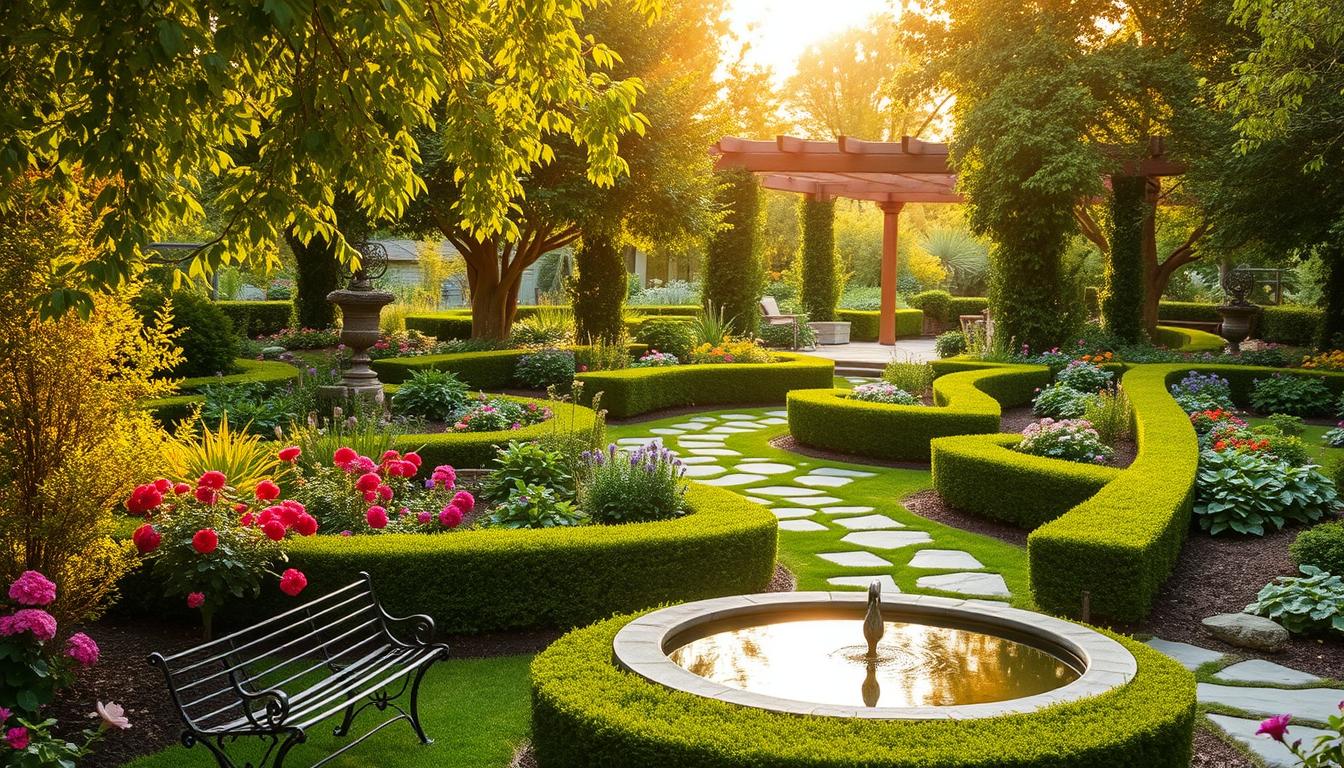Starting a garden can feel overwhelming, especially for beginners. Many homeowners struggle with where to begin or how to make the most of their space. With 18 years of expertise, we’re here to simplify the process and help you create a thriving outdoor area.
Understanding key elements like sunlight, water access, and soil quality is essential. For those with poor soil, raised beds or community gardens can be excellent alternatives. Starting small, like with a 10’x10′ plot, makes the process more manageable and less intimidating.
At Three Acre Farm, we’ve seen success stories over our 15-year journey. Whether you’re growing plants for beauty or food, the right approach can make all the difference. To help you get started, we offer printable guides and spreadsheets from our Cut Flower Confidence series.
For those ready to dive deeper, our Backyard Cutting Garden 101 course provides step-by-step guidance. Don’t let analysis paralysis hold you back—start small, stay consistent, and watch your space transform.
Key Takeaways
- Understand sunlight, water, and soil needs for healthy plants.
- Consider raised beds or community gardens for poor soil.
- Start with a manageable 10’x10′ plot to avoid overwhelm.
- Use printable guides and spreadsheets for easy planning.
- Explore courses like Backyard Cutting Garden 101 for advanced tips.
Introduction to Garden Planning and Design
Embarking on a new outdoor project can feel daunting, but with the right approach, it becomes manageable. Structured planning is key to overcoming overwhelm. By breaking down the process into smaller steps, you can create a thriving area that suits your needs.
When I started my first outdoor project, I focused on creating multiple growing areas. This allowed me to experiment with different plants and learn what worked best. Over the years, I discovered that limiting myself to 5-10 plant species per season helped me master their care without feeling overwhelmed.
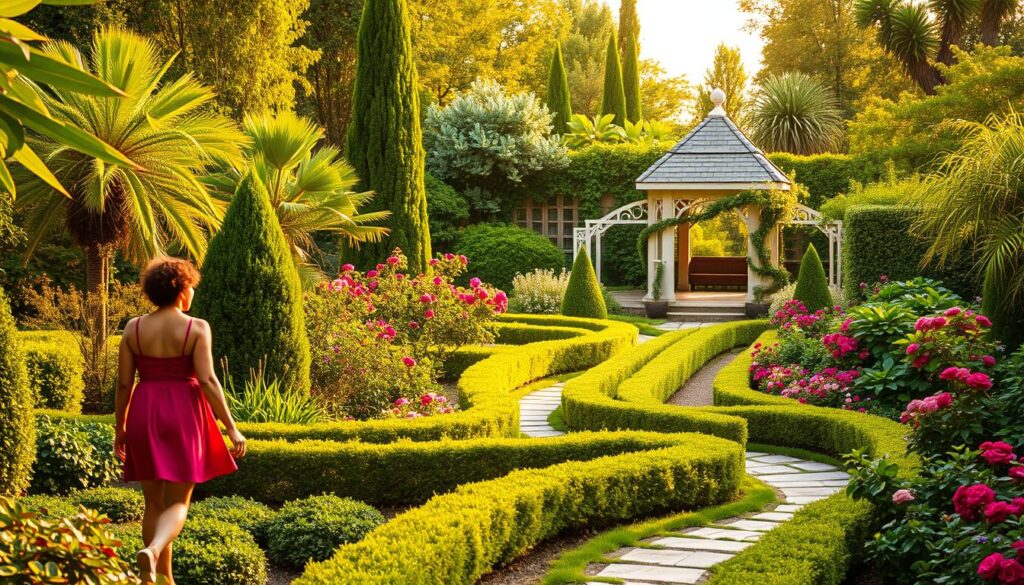
Constraints can actually lead to greater success. For example, working with a small space forces you to prioritize and plan efficiently. One of my favorite concepts is the idea of “living tapestries,” where kitchen gardens are designed to be both functional and visually stunning.
Seasonal planning is another essential aspect. By rotating crops and choosing plants that thrive in different seasons, you can enjoy a continuous harvest. Tools like the Almanac Garden Planner offer over 800 layout options, making it easier to visualize your space.
Design elements like trellis systems from Gardenary can add both beauty and functionality. They help maximize vertical space and prevent overcrowding, a common beginner mistake. Remember, a well-thought-out layout enhances the overall aesthetics of your outdoor area.
| Key Tip | Benefit |
|---|---|
| Start with 5-10 plant species | Reduces overwhelm and improves focus |
| Use seasonal planning | Ensures continuous harvests |
| Incorporate trellis systems | Maximizes space and adds visual appeal |
Choosing the Perfect Location for Your Garden
The location you choose can make or break your gardening efforts. A well-thought-out spot ensures your plants get the resources they need to thrive. Start by evaluating three critical factors: sunlight, water access, and soil quality.
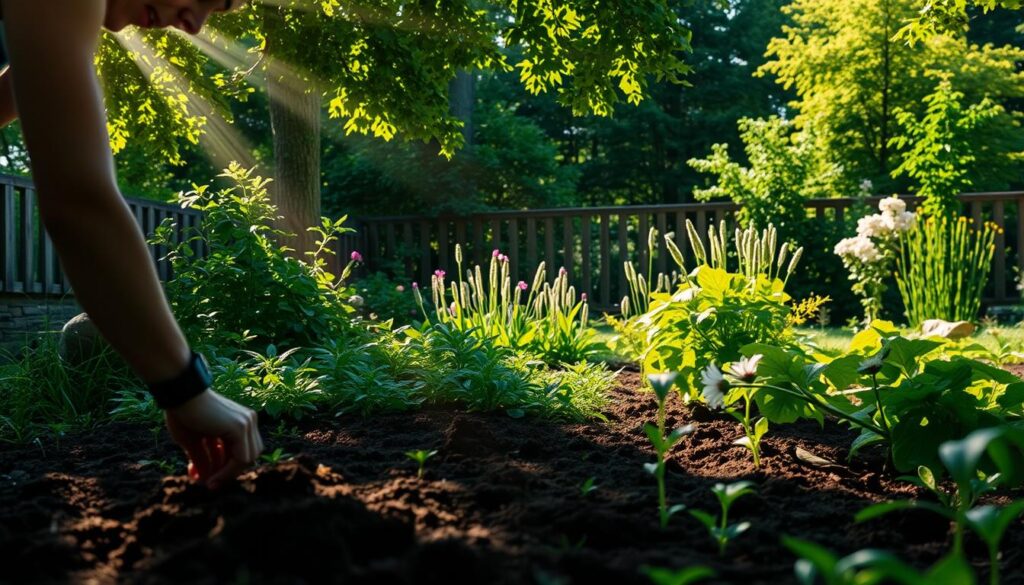
Assessing Sunlight and Water Access
Most veggies and flowers require at least 8 hours of direct sunlight daily. Track the sun’s movement across your space to identify the brightest areas. Use tools like sun-tracking apps or simple observation over a few days.
Water access is equally important. Make sure your chosen spot is near a water source or consider installing a drip irrigation system. This setup ensures consistent hydration, especially during dry spells.
Evaluating Soil Quality
Healthy soil is the backbone of a thriving garden. Avoid heavy clay or sandy soils, as they can hinder plant growth. Test your soil using a kit to determine its pH and nutrient levels.
If your soil isn’t ideal, raised beds are a fantastic solution. They allow you to control the soil mix and improve drainage. For those with limited space, vertical gardens or community garden rentals are creative alternatives.
By focusing on these factors, you’ll create a space where your plants can flourish. Remember, a little planning goes a long way in ensuring success.
Starting Small: Tips for Beginner Gardeners
Small beginnings can lead to big successes in your outdoor space. A 10’x10′ plot is an excellent way to start. It’s manageable, reduces overwhelm, and allows you to focus on learning the basics. Many beginners find that starting small helps build confidence over time.
One of the best philosophies to adopt is that constraint is the secret to success. By limiting yourself to 5-10 new plant species per season, you can master their care without feeling overwhelmed. This approach also helps you understand what works best in your space.

For those who want to grow but lack space, container gardening is a fantastic alternative. It’s budget-friendly and perfect for patios or balconies. Over the years, you can gradually expand your efforts as you gain experience.
Community gardening is another great option. It provides access to shared resources and fosters a sense of community. Plus, it’s a wonderful way to learn from others and share tips.
To avoid common mistakes, follow a simple checklist. Start with easy-to-grow plants, allocate time for maintenance, and consider whether to begin with seeds or nursery plants. For more guidance, explore resources like Gardening for Beginners.
Remember, the key is to start small, stay consistent, and enjoy the process. Your outdoor space will transform with patience and effort.
Creating a Garden Layout: From Sketch to Reality
Transforming your outdoor area into a functional and beautiful space starts with a solid layout. A well-thought-out plan ensures every inch of your space is utilized effectively. Whether you’re a beginner or an experienced gardener, mapping out your ideas is the first step to success.

Using Graph Paper or Software
Graph paper is a classic tool for sketching your layout. It’s simple, affordable, and allows you to visualize your space in a grid format. For those who prefer digital tools, software like the Almanac Garden Planner offers over 800 layout options. Spreadsheets are another great option, especially for tracking plant spacing and succession planting.
Each method has its benefits. Graph paper is tactile and easy to use, while software provides advanced features like drag-and-drop functionality. Spreadsheets are ideal for organizing data and creating detailed plans. Choose the tool that best fits your needs and skill level.
Designing Raised Beds and Pathways
Raised beds are a popular choice for maximizing space and improving soil quality. A 3’x12′ configuration is ideal for accessibility and efficient plant care. When designing raised beds, consider materials like cedar or composite wood for durability and cost-effectiveness.
Pathways are just as important as the beds themselves. Gravel or mulch can be used for surfacing, providing a clean and functional walkway. Ensure pathways are wide enough for easy access, especially for those with mobility concerns. Companion planting and vertical integration using trellises can further enhance your layout.
By carefully planning your raised beds and pathways, you’ll create a space that’s both practical and visually appealing. Remember, a good layout is the foundation of a thriving outdoor area.
Selecting the Right Plants for Your Garden
Choosing the right plants can make your outdoor space thrive. Whether you’re growing flowers or vegetables, the key is to pick varieties that suit your environment and skill level. Beginners often find success with easy-to-grow options like sunflowers, zinnias, and cosmos.
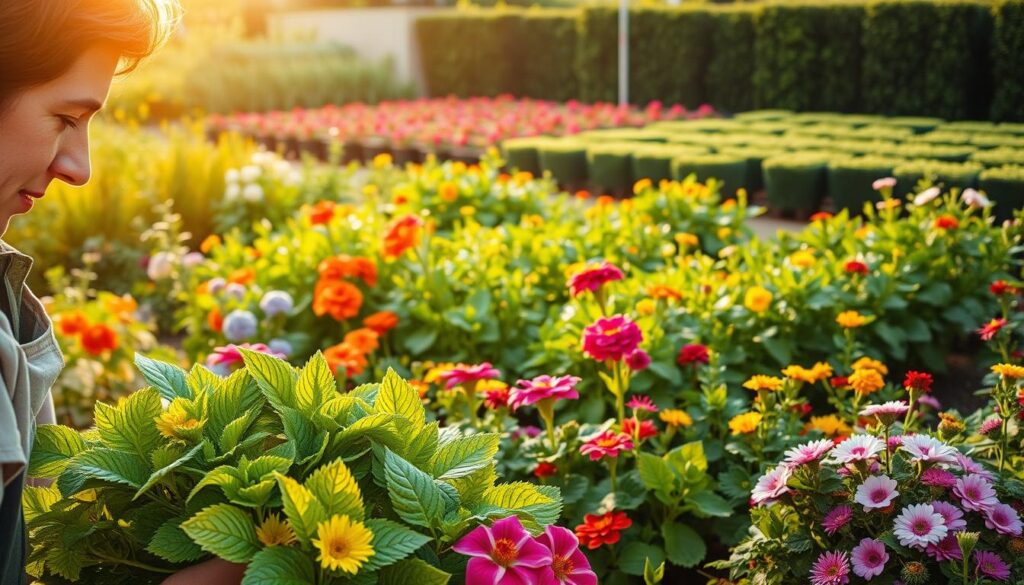
Beginner-Friendly Options
Starting with simple plants builds confidence and ensures success. Sunflowers are a great choice for their resilience and vibrant blooms. Zinnias and cosmos are also beginner-friendly, offering long-lasting flowers with minimal care.
For those interested in growing food, consider container-friendly vegetables like cherry tomatoes or lettuce. These varieties are compact and perfect for small spaces. Pollinator-friendly flowers like lavender and marigolds can also enhance your space while supporting local wildlife.
Planning for Seasonal Varieties
Seasonal planning ensures a continuous harvest and vibrant blooms throughout the year. Start by creating a calendar to track planting and blooming times. Cool-season crops like spinach and kale thrive in early spring, while warm-season plants like peppers and cucumbers excel in summer.
Heirloom varieties offer unique flavors and colors, while hybrids often provide better disease resistance. Presprouting seeds can speed up growth, and seed-saving techniques allow you to reuse your favorite plants year after year.
- Check hardiness zone-specific charts for suitable plants.
- Include pollinator-friendly flowers to support local ecosystems.
- Create a continuous bloom calendar for year-round color.
- Compare heirloom and hybrid varieties for diversity.
- Experiment with microgreens for quick, nutritious harvests.
By selecting the right plants and planning for each season, you can create a thriving and beautiful outdoor space. Whether you’re growing flowers or vegetables, the right choices make all the difference.
Maximizing Space with Trellises and Vertical Gardening
Vertical gardening is a game-changer for small spaces. It allows you to grow more plants without needing extra ground area. Trellises and vertical structures not only save space but also add visual interest to your outdoor area.
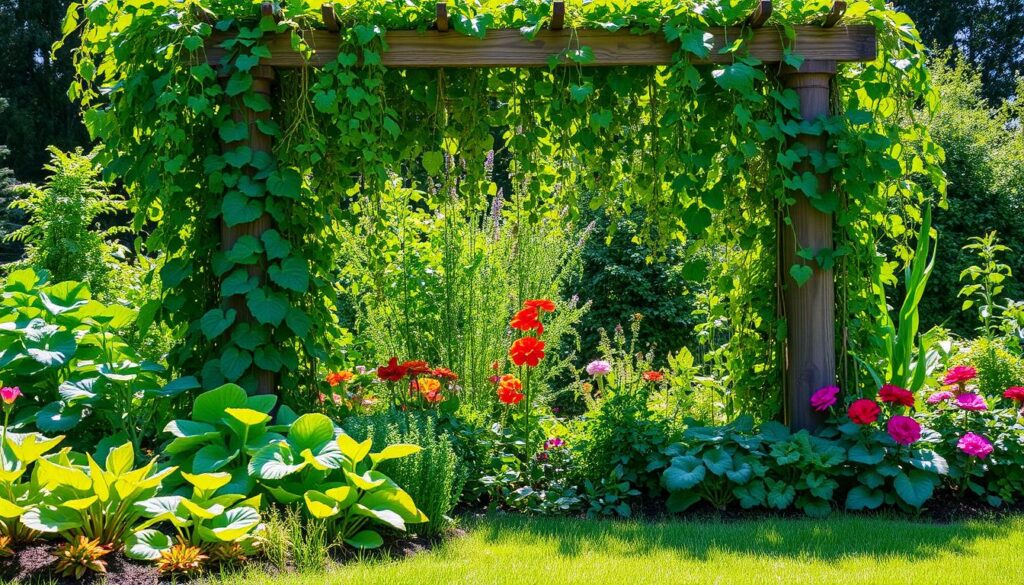
Trellises provide essential support for climbing plants like tomatoes, cucumbers, and pole beans. They improve air circulation, reducing the risk of disease. Plus, they make harvesting easier by keeping plants off the ground.
Living walls are another creative way to maximize space. These vertical gardens can be customized to fit any area, from small balconies to large backyards. They’re perfect for adding greenery to urban settings.
When designing your vertical setup, balance functionality with aesthetics. Decorative trellises can double as privacy screens, while functional ones focus on plant support. DIY trellis projects are budget-friendly and allow for personalization.
For year-round interest, choose plants that thrive in different seasons. Evergreen vines or winter-hardy climbers can keep your trellis vibrant even in colder months. Vertical hydroponic systems are another innovative option for growing herbs and greens indoors.
Whether you’re a beginner or an experienced gardener, vertical gardening opens up new possibilities. It’s a smart way to make the most of your garden space while creating a stunning outdoor environment.
Raised Bed Gardening: Benefits and Setup
Raised beds offer a practical solution for growing healthy plants in limited areas. They provide better control over soil quality, improve drainage, and make maintenance easier. Whether you’re dealing with poor soil or limited mobility, raised beds can transform your growing experience.
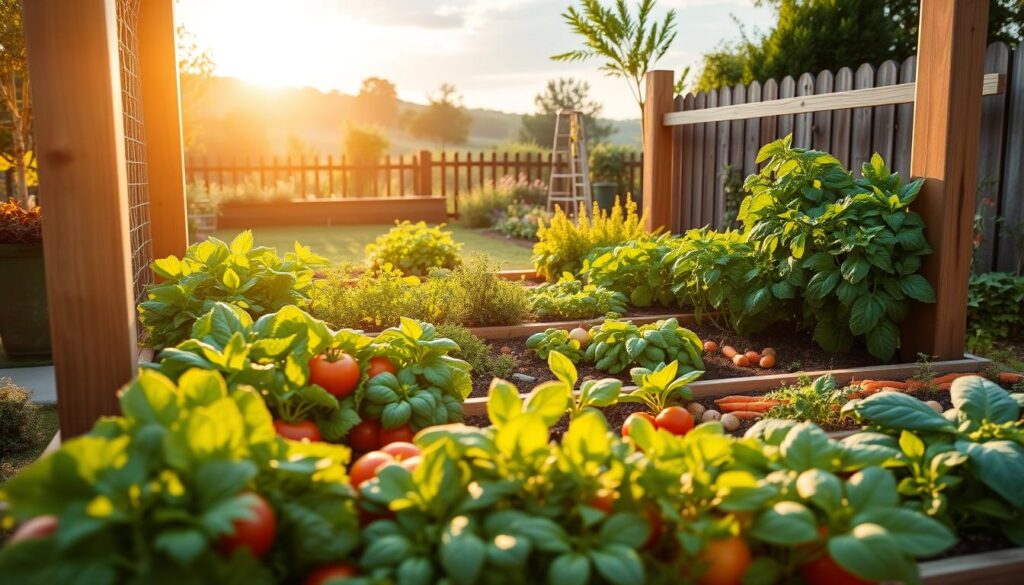
Building and Filling Raised Beds
Constructing raised beds is straightforward. A 3′ width is recommended for easy access from all sides. Cedar and composite wood are popular choices for durability and cost-effectiveness. Cedar naturally resists rot, while composite materials offer longevity with minimal maintenance.
When filling your bed, start with a drainage layer of gravel or coarse sand. This prevents waterlogging and promotes healthy root growth. Use a mix of potting soil, compost, and leaf mold for optimal fertility. This combination ensures your plants get the nutrients they need.
Choosing the Right Soil Mix
The soil mix is crucial for success. A blend of 60% potting soil, 30% compost, and 10% leaf mold works well for most plants. This mix provides a balance of nutrients, moisture retention, and aeration. Regularly amend the soil with compost to maintain its fertility.
For those on a budget, hugelkultur beds are a cost-effective option. They use logs and organic matter as a base, reducing the need for soil. Over time, the materials decompose, enriching the soil naturally.
| Material | Pros | Cons |
|---|---|---|
| Cedar | Natural rot resistance, durable | Higher initial cost |
| Composite | Long-lasting, low maintenance | Less eco-friendly |
- Ensure beds are wheelchair-accessible for inclusivity.
- Install pest barriers to protect your plants.
- Use season extension attachments for year-round growing.
- Follow Three Acre Farm’s maintenance routine for organic certification.
Designing a Kitchen Garden for Fresh Produce
Growing your own food is both rewarding and practical. A kitchen garden ensures a steady supply of fresh herbs, vegetables, and even flowers right at your fingertips. By following edible landscape principles, you can create a space that’s both functional and beautiful.
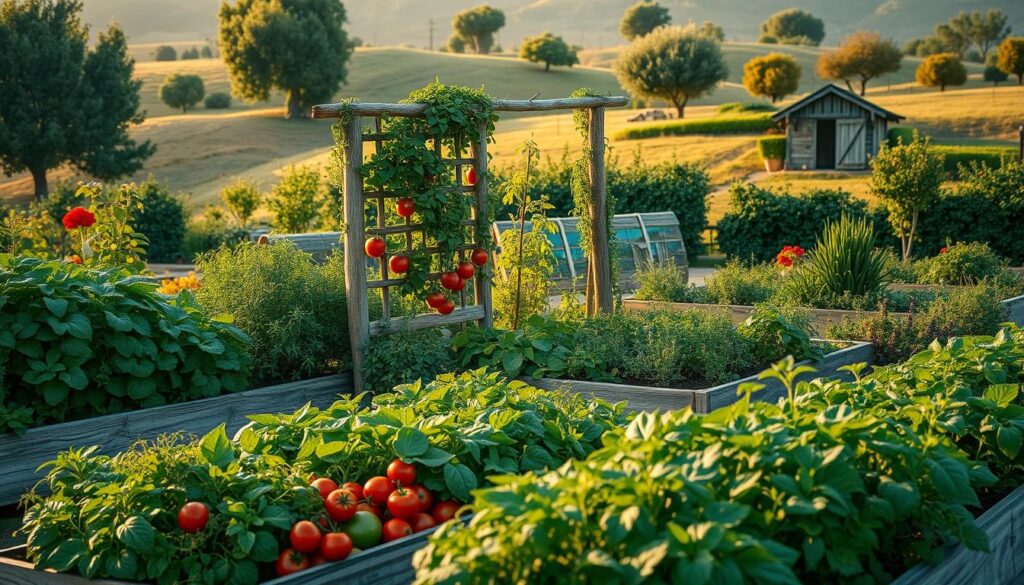
One key strategy is to plan for a continuous harvest. This involves selecting plants that mature at different times. For example, plant lettuce in early spring and tomatoes in late spring. This ensures you always have something fresh to pick.
Here are some creative ideas to enhance your kitchen garden:
- Use culinary herb spirals to maximize space and add visual interest.
- Build salad tables for easy access to greens.
- Incorporate companion planting to boost growth and deter pests.
- Plan succession planting schedules for year-round harvests.
- Add ornamental edible varieties like rainbow chard for a pop of color.
Containers are another great option, especially for small spaces. They allow you to grow herbs and vegetables on patios or balconies. Three Acre Farm’s potager plans offer detailed layouts for creating a functional and attractive kitchen garden.
For families, consider a children’s tasting garden. This introduces kids to fresh produce and encourages healthy eating. Restaurant-quality herb selections can also elevate your cooking with fresh flavors.
| Element | Benefit |
|---|---|
| Herb Spirals | Maximizes space, adds visual appeal |
| Salad Tables | Easy access, perfect for small spaces |
| Companion Planting | Boosts growth, deters pests naturally |
By integrating these ideas, you can create a kitchen garden that’s both productive and visually stunning. Whether you’re a beginner or an experienced gardener, these strategies ensure a bountiful harvest every year.
Incorporating Color and Beauty into Your Garden Design
Adding vibrant hues and natural charm to your outdoor space can transform it into a visual masterpiece. By carefully selecting flowers and shrubs, you can create a landscape that’s both stunning and functional. Let’s explore how to achieve this balance.
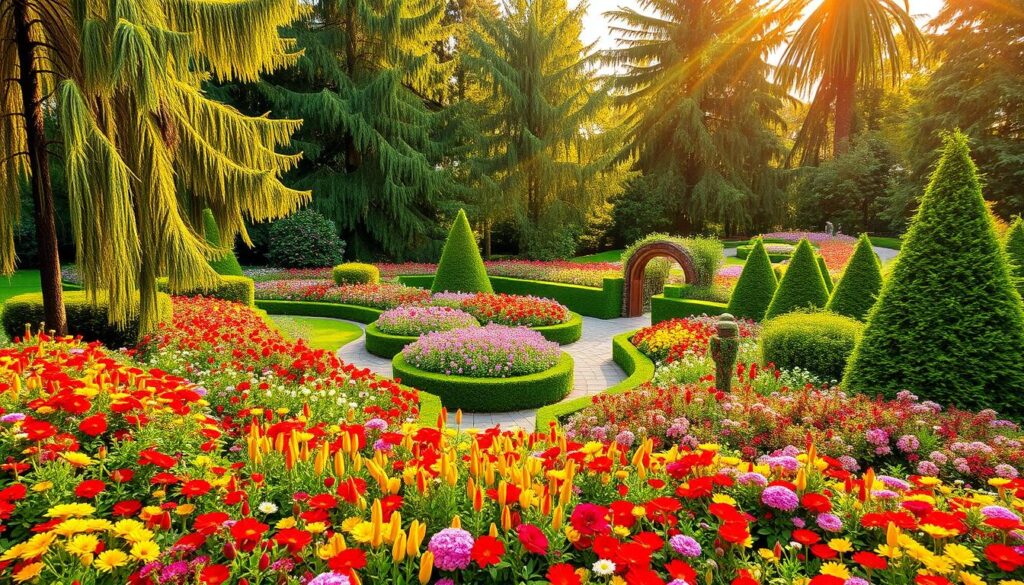
Using Flowers and Shrubs for Aesthetic Appeal
Choosing the right flowers and shrubs is key to creating a visually appealing space. Start by considering the color wheel theory. Complementary colors, like purple and yellow, create striking contrasts, while analogous colors, such as blue and green, offer a harmonious look.
Staggering bloom times ensures your landscape remains vibrant throughout the year. For example, plant tulips for spring, daylilies for summer, and chrysanthemums for fall. Evergreen shrubs provide structure and color even in winter.
Focal points, like a flowering tree or a sculptural border, draw the eye and add depth. Texture contrast, such as pairing delicate flowers with bold foliage, enhances visual interest. Scented flowers like lavender or roses add an extra layer of sensory appeal.
Creating a Cohesive Landscape
A cohesive landscape feels intentional and balanced. Start by defining your borders with low-maintenance perennials or ornamental grasses. These elements frame your space and create a polished look.
Living walls and vertical structures can serve as stunning entrances. They maximize space while adding greenery and color. Night lighting, such as solar-powered lanterns, extends the beauty of your landscape into the evening.
Wildlife-friendly designs, like pollinator gardens, support local ecosystems while adding charm. Artistic hardscaping, such as stone pathways or decorative trellises, complements the natural elements. Three Acre Farm’s border designs offer inspiration for creating a unified look.
- Apply the color wheel theory for harmonious combinations.
- Stagger bloom times for year-round interest.
- Use focal points to guide the viewer’s eye.
- Incorporate texture contrast for added depth.
- Add scented flowers for a sensory experience.
By thoughtfully integrating color, flowers, and shrubs, you can craft a landscape that’s both beautiful and cohesive. Whether you’re designing a border or a living wall, these tips will help you create a space that’s truly enchanting.
Conclusion: Turning Your Garden Dreams into Reality
Creating a thriving outdoor space is within your reach with the right tools and mindset. Over the years, we’ve seen how small, consistent efforts can transform any area into a lush, productive haven. Start with a clear plan and build from there.
To help make your journey smoother, consider using maintenance schedule templates and progress tracking methods. These tools ensure you stay on track and celebrate milestones along the way. Seasonal reflection prompts can also guide your growth and inspire new ideas.
Community building is another powerful way to enhance your experience. Share tips, swap plants, and learn from others. Three Acre Farm’s courses offer step-by-step guidance to make gardening easier and more enjoyable.
As you expand, think about legacy concepts that leave a lasting impact. Whether it’s a pollinator-friendly space or a family heirloom plot, your efforts can inspire others for years to come. Take the first step today and watch your dreams flourish.

